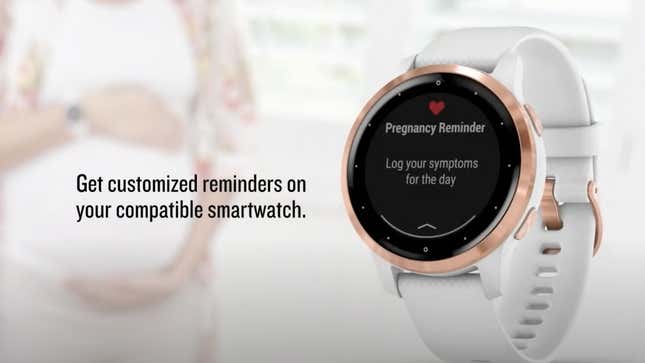
It took a stupid long time for wearables makers to add period tracking to their devices. Now, about 18 months after Garmin introduced period tracking to its devices, the company is now allowing users to track their pregnancy as well.
The feature is part of the Garmin Connect platform and will allow pregnant users to switch from logging periods to tracking pregnancy-specific symptoms, including baby movements and blood glucose levels. It’ll also provide weekly updates based on where a user is in their pregnancy. For instance, Garmin says users can get recommendations on how to adjust diet and exercise regimens, as well as receive guidance on typical symptoms for that week, baby size updates compared to fruits and vegetables, and what bodily changes can be expected. Users will also be able to get reminders for hydration and Kegels. And perhaps counter to what most people use fitness smartwatches for, pregnant users will also get weight gain recommendations depending on how far they’re along. In a nice touch, Garmin also has a downloadable Contraction Timer.
On the training side of things, pregnant users will also gain the ability to pause their training status and tweak high heart rate notifications, so they can adhere to doctor recommendations. They’ll also be able to log symptoms, like backaches, cravings, and nausea, within the app itself. To enable this, you first have to have a compatible Garmin. According to the list, compatible Garmin devices include the Forerunner series, the Fenix 5 and 6 series, the Marq series, Venu, and Vivoactive series. Some Marvel and Star Wars-branded Garmins are also compatible. If you have a compatible device, you can then go to the Garmin Connect app on your phone, and then select User Settings > Women’s Health > Cycle Type > Pregnancy. There’s also a downloadable Pregnancy Tracking Connect IQ app so users can log from the wrist.
Freaking finally. While smartwatches and fitness trackers are good at tracking your overall physical activity, they often don’t account for times when you might not able to train as normal. It’s pretty common to see smartwatches across brands encourage you to consistently pick up the pace or push for higher gains—even when your body may actually need you to slow down and recover. This is especially true with regard to pregnancy, as the body undergoes an incredibly exhausting transformation, and safe prenatal exercise—especially for heavily active athletes—often requires adjustments to routines and expectations. Pregnant folks also want to exercise, if this woman who went viral for running a sub-six minute mile while nine months pregnant is any indication. In that regard, it is a relief to see a wearables company take a more thoughtful approach to a major health condition that impacts millions of people every year.
Reproductive health tracking has gotten better in recent years, but fertility tech in general still has a long way to go. While some, like the Ava tracker, conduct clinical studies to better predict fertile windows, others have spectacularly dropped the ball. Last year, Ovia, a popular pregnancy tracking app, was found to have handed over intimate, private data to users’ employers. Another fertility app, Femm, was found to have been funded by anti-abortion campaigns.
There are, of course, questions with regard to privacy. HIPAA doesn’t cover user-generated data on wearables or health apps, and technically speaking, private companies don’t have to disclose exactly which third-party advertisers might see your aggregated health data. Gizmodo reached out to Garmin about how its specific privacy policy with regard to this pregnancy feature, and was directed to Garmin’s official privacy policy as well as its Garmin Connect privacy policy. In the latter, Garmin states that it doesn’t sell personal data with any third parties, but that it may share it internally, with service providers (such as order fulfillment), and law enforcement. It also notes that anonymized activity data may be shared with “strategic partners and other third parties.” This is a fairly typical policy for your average wearable maker but may not assuage the most privacy-minded among us.
Still, it’s nice to see that Garmin is thinking proactively with regard to how wearables might better help people track their reproductive health beyond menstrual cycles. While wearables burst onto the scene as early as 2011 and 2012, it took until 2018 before Fitbit became the first company to add period tracking on its devices. Garmin and Apple followed a year later. Meanwhile, Samsung didn’t add the feature until this year, even though users in its forums have been clamoring for it for years. Hopefully, other smartwatch makers will follow suit—in a thoughtful, mindful, and privacy-first way, of course.